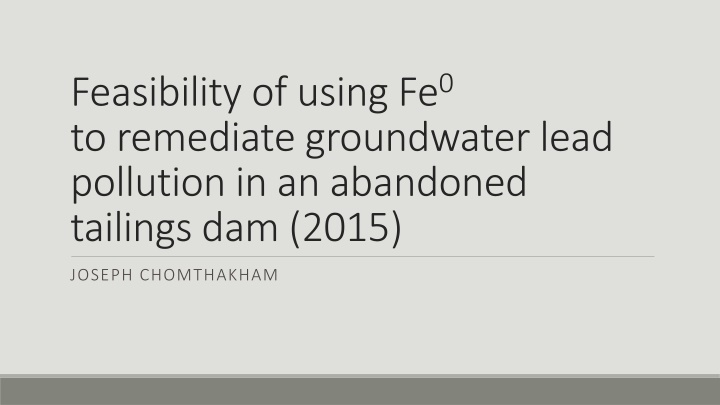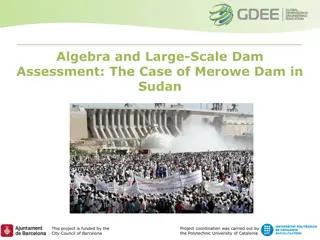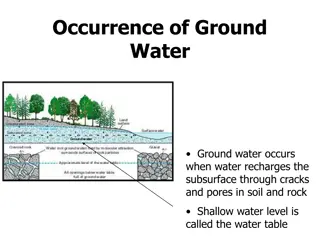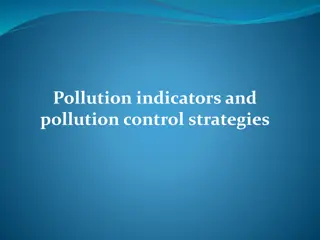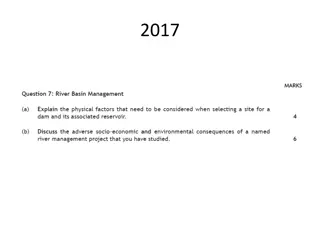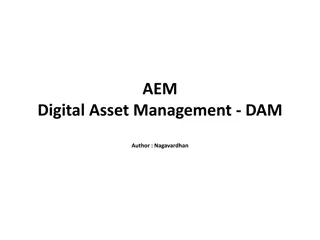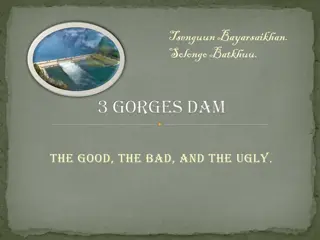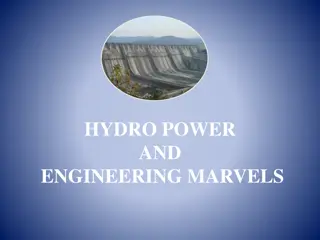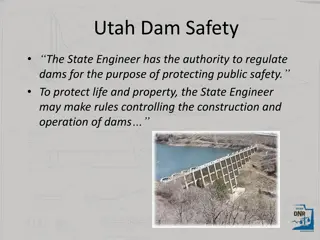Feasibility of Using Fe0 to Remediate Groundwater Lead Pollution in an Abandoned Tailings Dam
Heavy metal pollution in soil and groundwater from an abandoned tailings dam poses a persistent challenge. This study explores using iron (Fe0) in a Permeable Reactive Barrier (PRB) to remove lead (Pb) via redox reaction. The contaminated area, impacted by lead pollution, underwent experiments to assess the effectiveness of Fe0 in a PRB setup. Drilled holes revealed high concentrations of lead and zinc, prompting the selection of lead for experimental study due to its toxicity. The study involved water beaker batch experiments with varying iron particle sizes and lead nitrate concentrations to simulate the tailings dam environment using PVC columns. Different settings were applied to assess the impact on heavy metal removal.
Download Presentation

Please find below an Image/Link to download the presentation.
The content on the website is provided AS IS for your information and personal use only. It may not be sold, licensed, or shared on other websites without obtaining consent from the author.If you encounter any issues during the download, it is possible that the publisher has removed the file from their server.
You are allowed to download the files provided on this website for personal or commercial use, subject to the condition that they are used lawfully. All files are the property of their respective owners.
The content on the website is provided AS IS for your information and personal use only. It may not be sold, licensed, or shared on other websites without obtaining consent from the author.
E N D
Presentation Transcript
Feasibility of using Fe0 to remediate groundwater lead pollution in an abandoned tailings dam (2015) JOSEPH CHOMTHAKHAM
Introduction Main Issue: Heavy metal pollution of the soil and groundwater due to human activity in the tailings dam is very persistent and difficult to get rid of. A basic concept of a PRB Concept: Experimenting and finding out the effectiveness of using iron (Fe0)as a reaction medium in a Permeable reactive barrier (PRB) to remove heavy metals such as lead [Pb(II)] via redox reaction. Permeable Reactive Barrier (PRB): A barrier that allows some but not all materials to pass through. The idea is to capture the contaminates in the water and allow uncontaminated water to pass through.
Background & Geographic Information Tailings dam: Typically, an earth-fill embankment dam to store byproducts of mining operations after the ore is separated and retrieved. Mining history: Began in 1949, large scale mining began in 1999, and the Dajiaoling lead- zinc mine was closed in 2008 due to demand for environmental protection The polluted area reached about 530km2 and had over 1 million meters of waste ore, tailings and waste residue. The tailings dam has a great influence on the surrounding environment, due to the design and construction of the tailings dam and an adjacent river flows into the Dongjiang Lake within 2km of the dam.
Lead [Pb(II)] Pollution in the area Drilled holes to sample concentrations of heavy metals Zinc(Zn), Lead(Pb), Arsenic(As), and Copper(Cu). The four heavy metals were distributed from 49 ppm to 27,110 ppm. Average content was 3649.4 ppm. Zn and Pb had the highest levels at an average of 9100.7 ppm and 4593.3 ppm which accounts for 93.81% of the total heavy metal content Lead was selected as the experimental study due to its toxicity compared to Zinc.
Methods and Materials Water Beaker Batch Experiments Materials: Pure Iron(Fe0) powder with particle sizes of 100mesh, 300mesh, 400 mesh. Pure Lead Nitrate [Pb(NO3)2] prepared as a 150 mg/L Experimental soil diluted with HCL for 48 hours then rinsed multiple times with tap water and then diluted water Experimental Device A PVC column with a sealed bottom and a plastic pipe that connected as a water outlet. The PVC column was filled with soils in a way to simulate the tailings dam. There were 12 PVCs with various settings to them.
PVCs and their settings Each PVC was set up differently to undergo different types of environments and testing. Some consist of different iron to sand ratios, some consist of sawdust and activated carbon, etc
Methods and Materials Experimental Method: Table 2 shows the conditions of the experiment. 3 tests were done at each level. During the experiment, Pb(II) Solution was injected into an oscillating PVC column via flow pump. To simulate the tailings dam. Then Fe0 powder flowed in after 17 hours. The experiment lasted 60 days. Tested for optimal experimental parameters (sizes, concentrations and reaction time) and factors such as pH, copper plating to the iron powder, etc
Results As reaction times increased, so did removal rate. As particle size of Iron powder increased, so did removal rate. Initial concentration of the Lead solution had little to no effect on the removal rate of Lead. The best experiment was #7 at 97.1% removal rate.
Acid pre-treatment Results Experiments were given iron powder that were soaked in dilute hydrochloric acid Reason: To remove any oxide film on its surface In the first 20 mins, there is no significant difference After the 20 min mark, removal rates increased significantly for acid treated iron powder.
Binary Metals Results Binary metals were added and combined with the iron powder, mainly Copper and Nickel Copper (non-plated, 1%, 10%, 20%) First 10 mins, little to no difference.After 20 mins, the significance of copper plating showed. Non plated copper was only at 28.2% and copper plating increased the removal rate significantly. 76.8% at the 20 min mark for the 20% combination
Binary Metals Results Nickel (non-plated, 1%, 10%, 20%) Although it makes removal slightly more effective, There is no significant increase of lead removal at any times for any amounts of nickel.
Oscillation Results Tested under different conditions of oscillation. Oscillations were used to simulate water flow. Although there was a significance in the early stages of the experiment (between 0 20 mins), it had little to no effect at the end and removal rates caught up by 30 mins.
Temperature Results Experiments were tested at different temperatures to see if temperature had an effect on lead removal. It had little to no effect.
pH Results Experiments went through different pH levels to see whether or not pH had an effect on lead removal. The lower the pH, the better the effect pH always affected the lead removal rate from beginning to end. Low pH favors the removal of contaminants by Fe0
Iron to Sand Ratio Results Different iron to sand ratios were tested. Removal efficiency increases when the Iron to sand ratio is higher. When there is relatively more iron compared to the sand. Optimal ratio of iron to sand is 12:1 (legend references table 3)
Conclusions Fe0 removal of Pb(II) ions is a redox reaction. The best combination/experiment to remove lead concentrations is an iron powder size of 400mesh, initial concentration of Pb(II) at 10 mg/L, and a reaction time of 90 minutes. It removed 97.1% of lead. Initial concentrations of Pb(II) have no significant effect. Particle size and longer reaction times have shown to have increased effects. Pre-treated hydrochloric acid reduces the amount of iron powder needed and improves reaction rate at the same time. Binary metals such as Copper and Nickel significantly accelerate the reaction. Copper plating had the most significant differences. As the mass ratio of iron to sand increases, so does removal efficiency. 12:1 is the best ratio.
References Gao, F., Wang, Q., Zhou, K., Li, J., & Lin, H. H. (2019, September 30). Feasibility of using Fe0 to remediate groundwater lead pollution in an abandoned tailings dam. Retrieved December 8, 2019, from http://faculty.uml.edu/nelson_eby/89.315/Professional Papers/Gao2019_Article_FeasibilityOfUsingFe0ToRemedia.pdf.
